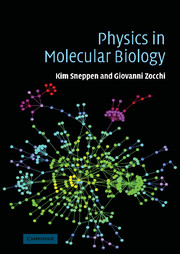Book contents
- Frontmatter
- Contents
- Preface
- Introduction
- 1 What is special about living matter?
- 2 Polymer physics
- 3 DNA and RNA
- 4 Protein structure
- 5 Protein folding
- 6 Protein in action: molecular motors
- 7 Physics of genetic regulation: the λ-phage in E. coli
- 8 Molecular networks
- 9 Evolution
- Appendix Concepts from statistical mechanics and damped dynamics
- Glossary
- Index
1 - What is special about living matter?
Published online by Cambridge University Press: 06 July 2010
- Frontmatter
- Contents
- Preface
- Introduction
- 1 What is special about living matter?
- 2 Polymer physics
- 3 DNA and RNA
- 4 Protein structure
- 5 Protein folding
- 6 Protein in action: molecular motors
- 7 Physics of genetic regulation: the λ-phage in E. coli
- 8 Molecular networks
- 9 Evolution
- Appendix Concepts from statistical mechanics and damped dynamics
- Glossary
- Index
Summary
Life is self-reproducing, persistent (we are ∼ 4 × 109 years old), complex (of the order of 1000 different molecules make up even the simplest cell), “more” than the sum of its parts (arbitrarily dividing an organism kills it), it harvests energy and it evolves. Essential processes for life take place from the scale of a single water molecule to balancing the atmosphere of the planet. In this book we will discuss the modeling and physics associated, in particular, to the molecules of life and how together they form something that can work as a living cell. First we briefly review some basic concepts of living systems, with emphasis on what makes biological systems so different from the systems that one normally studies in physics.
Conceptually, molecular biology has provided us with a few fundamental/universal mechanisms that apply over and over. Some concepts, like evolution, do not have counterparts in physics. Others, like the role of stochastic processes, are, on the contrary, quite familiar to a physicist.
(1) Biology is the result of a historical process. This means that it is not possible to “explain” a biological system by applying a few fundamental laws in the same way that is done in physics. A hydrogen atom could not be different from what it is, based on what we know of the laws of nature, but an E. coli cell could. In evolution, it is much easier to modify existing mechanisms than to invent new ones. Thus on evolutionary timescales nearly everything comes about by cut and paste of modules that are already working. We will end the book with a chapter dedicated to evolutionary concepts and models.
[…]
- Type
- Chapter
- Information
- Physics in Molecular Biology , pp. 4 - 7Publisher: Cambridge University PressPrint publication year: 2005



